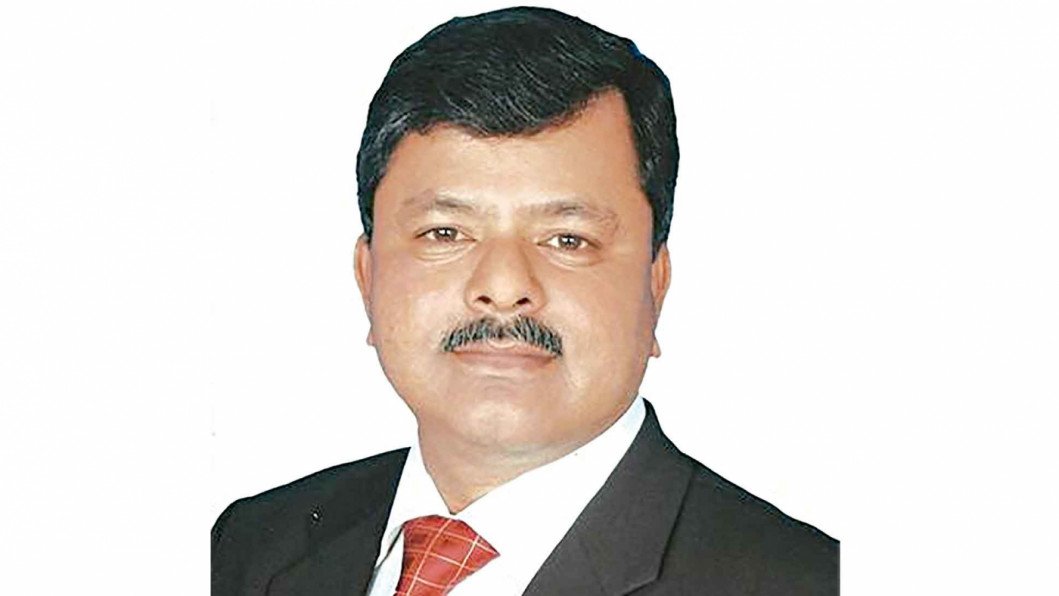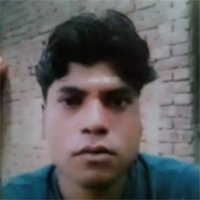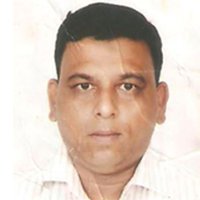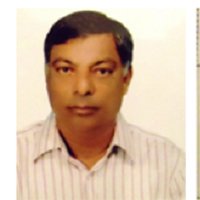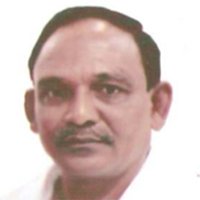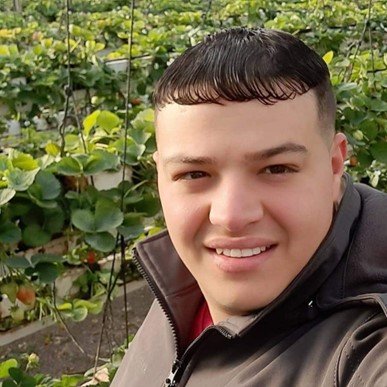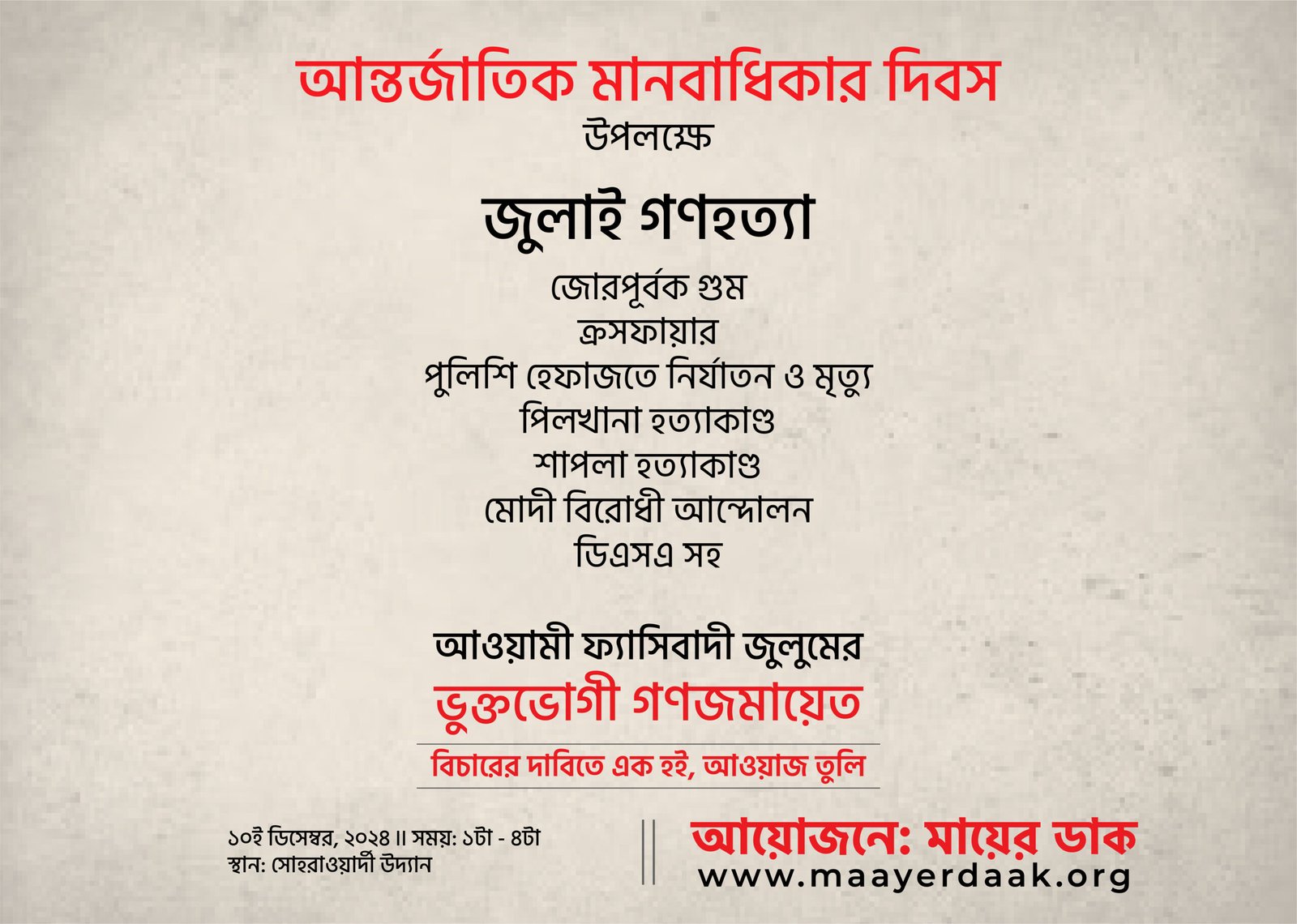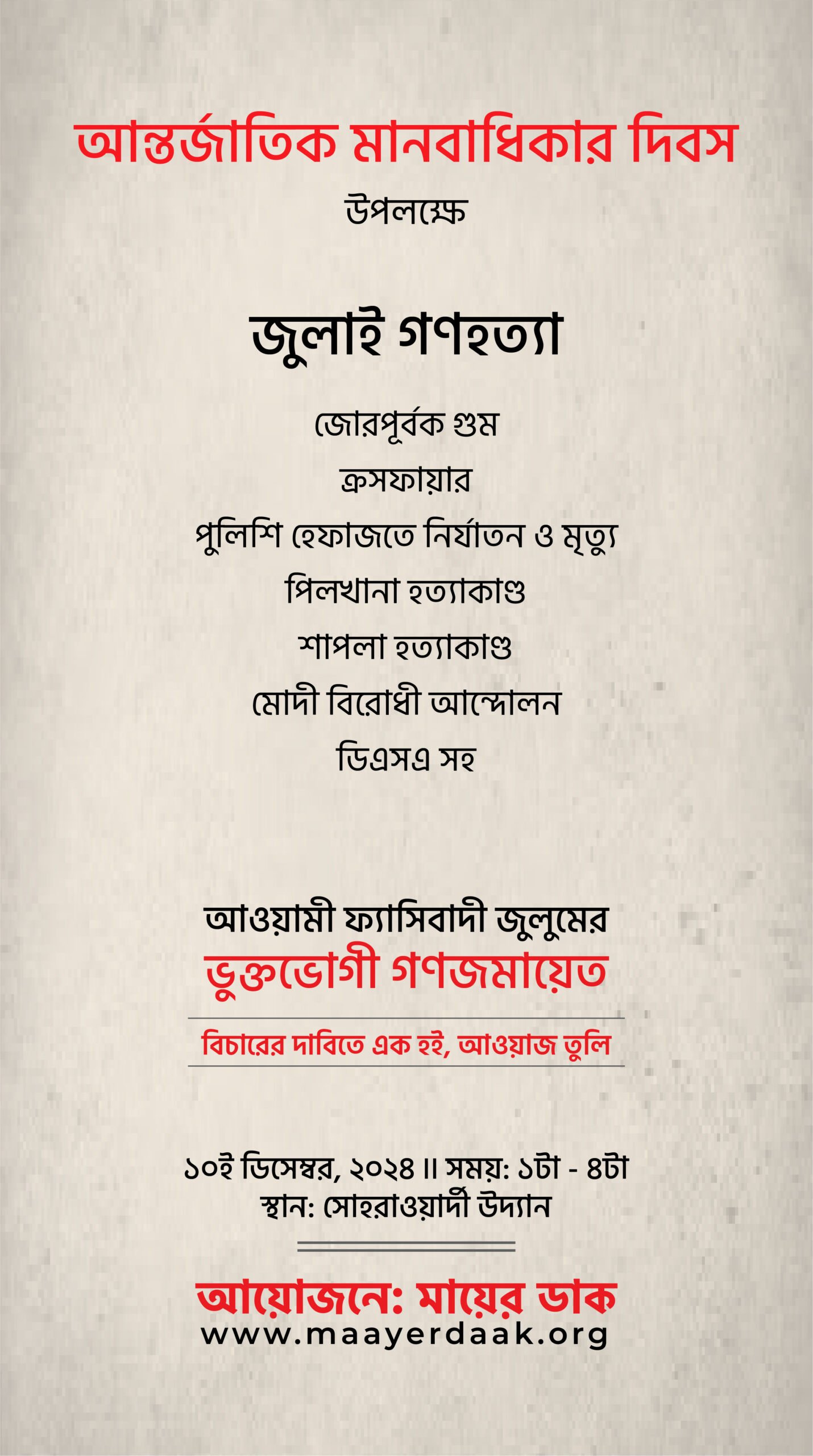At about 8 p.m. on December 4, 2013, Sajedul Islam Sumon, Mazharul Islam Russel, Abdul Quader Bhuiyan, Asaduzzaman Rana, and Zahidul Islam Tanvir were picked up by Rapid Action Battalion (RAB) officers outside a building under construction in Dhaka’s Bashundhara Residential Area. Sumon was the only post-holder for the Bangladesh nationalist party (BNP), and according to family members, the only one with a criminal case filed against him; the others were all supporters and activists. There were two other men present at the time, but they managed to escape.
One of the two men who escaped said that the meeting had been called by Sumon. RAB officers arrived soon after:
“For 40 or 45 minutes we were chatting. We were talking about the momentum of protest. After that, four of the men left by foot, leaving four of us—Tanvir, Sumon, myself, and [name withheld] behind. Two of us then went to the other side of a cement mixing machine to have a smoke. Suddenly we saw vehicles approaching. There was more than one car, but I can’t say exactly how many. There were some men in black uniforms who came out of the vehicles. They had weapons. The cars had their lights on so I could see the men, the color of their uniform. There was one car with “RAB-1″ written on it. I am sure that it was definitely RAB because of the clothes, and because I saw RAB-1 logo on the car. I could make out that people were being taken into a vehicle and that it left.”1
A construction worker at the site who witnessed the detention said he knew Tanvir because the family owned the property and had seen Sumon earlier. He said:
“Tanvir and Sumon were still standing there talking when the vehicles came. Four of the men [who came down from the vehicle] wore civil dress and another seven or eight were dressed in the black clothing of RAB, with a cloth around the head. All the men had guns. Sumon and Tanvir were both beaten up before they were put in the car. “Why you are arresting us, we are not these type of people,” they said at the time of being picked up.”2
Six hours later, early the following morning, a contractor said he was returning from a night shift to Shaheen Bagh, the area where Sumon’s family lives, when he saw Sumon, whom he knew well, inside a car that he thought belonged to law enforcement authorities.3
Sumon was not at that time staying at his home in Shaheen Bagh because he feared arrest, and was instead living with his cousin, Tanvir, at their apartment in Bashundhara Residential Area. Sumon’s sister, Sanjida Islam, said that they first heard that Sumon had been picked up when her family in Shaheen Bagh received a call from her aunt, Tanvir’s mother:
“My aunt said that it was RAB. Within half an hour my older sister, my husband, and my mother went to the RAB office in Uttara. I was pregnant at the time so I did not go. RAB people at the gate did not allow my family members in. The men at the reception denied they were involved in the detention. My sister, father, and mother stayed outside the RAB office throughout that night, and for the next three days one family member or the other was present outside the RAB office.”4
At about 11 p.m., one of the two men who had escaped being picked up came to their house though the back entrance. He told the family that Sumon had been taken away in RAB vehicles. The following day, Sanjida said that family members went to file a complaint with police:
“The next day my mother and older sister went to our local police station in Tejgaon to file a GD but the police said that they had to go to the police station of the PO [place of occurrence]. They then went to Vatara Police Station but the duty officer refused to allow them to file the GD if they claimed that RAB had taken my brother. They said that they could only give a GD if they said that Sumon was missing. As we did not want to do that, we did not file a GD.”5
Through family connections, Sumon’s family contacted a senior RAB officer [name withheld]:
“He began to speak to my mother on the phone, and to send messages. He made her believe that Sumon was going to be released soon. He said for example one day, “He will be with you next time you say your prayers.” Many times, he said that they were going to release Sumon. But nothing happened. This went on for two months.”6
Family members continued go to the RAB-1 office and RAB headquarters. At the end of January, Sumon’s mother and sister were invited to the office to meet an RAB-1 officer. Sanjida said:
“He admitted that Sumon had been detained. They praised my brother, saying that Sumon is good person, had a good reputation. He said that his boss had gone to see Sumon recently, to make sure he was all right in their custody. He suggested to us that we should communicate with Ziaul Ahsan, who was in charge of operations. He gave Ahsan’s landline and mobile number to my mother. When we met Ahsan, he was very arrogant. He said, “Why are so many army officials calling about Sumon? We have told you that we don’t have him and that we are searching for him.””7
The family gave its first written complaint to RAB on March 18, 2014, and has since given at least 12 further complaints to RAB (most recently on August 21, 2016), and five to other government authorities, including the home ministry, police, and military intelligence. The family has also made a complaint to the National Human Rights Commission and filed a habeas corpus petition in court.
In May 2016, Sanjida met again with one of the RAB officials the family had met earlier, who had been a senior RAB-1 officer at the time of her brother’s disappearance, but had since left. He confirmed in a private meeting at a restaurant that RAB-1 had conducted the operation to pick up Sumon. He said that the six men had been in his custody and that he received an order to kill them, but he refused.8
According to Sanjida, the official said that RAB’s counterterrorism branch—under the command of Lt. Col. Abul Kalam Azad, who subsequently became head of RAB’s intelligence wing—took the men from his custody. The official assumed they had been killed.9 In August 2016, Sanjida met with Azad, but he denied any involvement and, according to Sanjida, said: “We are searching. I will try to let you know whether he is alive or anywhere else.”
Russel’s sister, Nusrat Jahan Laboni, said she waited all night for her brother to come home, and in the morning discovered that his friends were missing as well.10 Family members approached RAB, DB, and various police stations several times but no one had any information about the detentions.11
Amin’s father filed a missing person GD at Badda Police Station that covered the area where they lived.12 The family also managed to file a First Information Report on January 26, 2014.13 Amin’s cousin, Yakoob, went to the construction site and the workers recognized his photograph, confirming that Amin was detained by RAB-1:
“I asked the workers how they knew that it was specifically RAB-1. They said that the security guards who work in that area are a little educated. After Al Amin Bhai and his friends were taken away by RAB, the workers went running toward the security guards, and the security guards told them that the vehicles had “RAB-1″ written on them.”14
Yakoob also went to the RAB office, where officials asked questions about witnesses to the abductions:
“The RAB officer asked me if I had any record or proof with me about the complaint. I replied to them that I had a recording of the statement that the workers and the caretaker gave. I showed the officer the recording. He took a record of the recording. Then I left the office and came back home. Afterward, I again contacted the officer to ask them if he has found anything about them yet. The officer replied that he will call us when it will be time. I called him three more times, but he couldn’t tell me anything else.”15
Masum’s mother, Ayesha Ali, said the family went to a number of police stations: “They said that no one had been arrested. On December 6, we went to file a GD in Tejgaon industrial area, but they only accepted a GD if we said that he was missing.”16
Rana’s sister, Meenara Begum, said that she too went to the police and RAB offices after she heard of the detention. They also filed a police complaint reporting that Rana was missing.17
Tanvir and Sumon are cousins. Tanvir’s mother, Nilifur Rana, also said that she went with her relatives to meet with RAB and DB officers, but everyone denied the detention.18
A year after the detentions, in December 2014, Sumon’s family made a formal complaint to the National Human Rights Commission. On December 17, the then chair of the NHRC wrote to the most senior civil servant of the home ministry setting out the allegation and “appealing to the government to take necessary action to bring back the son of Hazera Khatun and the others to the parents,” and to inform NHRC what action the ministry had taken by January 15, 2015.19
The ministry did not respond to this letter or to six other monthly reminders that the NHRC sent. However, on August 28, 2015, the ministry finally replied, stating that Sumon’s father had filed a case with the Vatara Police Station on January 26, 2014, and that the case was under investigation.20 In a letter dated November 15, 2015, Sumon’s mother wrote that they had never filed a case of this kind because when they had gone to do so “the police refused to take the case.”21
The NHRC then wrote to the ministry stating that the police report did not contain any specific step as to “how you are trying to get the victims back,” and asked for a detailed report by December 20, 2015. On January 14, 2016, police sent a letter to Sumon’s mother asking her to come to the police station. This meeting never took place. Instead, Sumon’s family sent a note to the police setting out the details of Sumon’s disappearance.
In March 2016, Sumon’s mother filed a habeas corpus petition before the High Court.22 She said that her son was illegally detained by RAB. The petition said that authorities had shown no inclination to investigate the incident, and that the court should order government authorities to produce him before the court.
On March 10, 2016, the court passed a rule nisi calling upon the Bangladesh government and various policing bodies to “show cause as to why the arrest/abduction/causing disappearance of the petitioner’s son Sajedul Islam Sumon … should not be declared to be illegal and without lawful jurisdiction,” and pass such orders as the court considers necessary.23
Following this order, the inspector general of police responded in an affidavit, “It was learnt from the respective units that neither Rapid Action Battalion nor any other unit of Bangladesh Police arrested said Sajedul Islam Sumon.”24 RAB also filed an affidavit with the court stating, “RAB-1 did not pick up or arrest the petitioner’s son Sajedul Islam Sumon and others,” and that “we are trying to find out the victims.”25
There had been no further court hearing at time of writing, since the High Court passed its order.
Amin’s family was the only one to file a FIR involving the abduction.26 His nephew, Yakoob Ali, said that some six months after the case was filed, an officer from the Vatara Police Station called and asked if the family had received news about Amin. “I said that it was the police that were supposed to be the ones providing the information.”27
In response to the court order following the habeas corpus petition by Sumon’s family, the police filed documents relating to its investigation into Amin’s family’s FIR with the court. These stated that after Amin’s father filed a case in January 2014, a police inspector had prepared a draft map; taken statements from the petitioner, people in the surrounding area, and a witness, and had collected the victim’s mobile phone records. Police said that three investigating officers had been assigned to, and then taken off, the case. The police reports concluded by saying the investigation revealed that along with Amin, Sumon had also been abducted by “an organized criminal gang” that they were trying to identify and catch. It stated: “The case is under investigation and we are deploying modern technologies.”28
Dhaka Metropolitan Police authorities also said that on November 19, 2014, the investigation responsibility was transferred to the DB of the police.29 In April 2016, following the March court order seeking state response to the habeas corpus petition, DB officials contacted Amin’s family and asked to get more information about the incident. Amin’s cousin said that the whole exercise was cruel and farcical: “I felt it was like a joke—him coming after three years and asking about [my cousin] like this. He said, ‘Don’t worry, you will get justice.’”
Sumon’s sister, Afroja Islam Aqi, said that she, her sisters, and her mother went to the RAB office every week for five years after her brother was disappeared. But every time RAB denied everything. “We were begging and begging but they gave nothing.”30 Sumon’s mother, Hajera, says his daughters ask for him often, which she says brings her great pain. “If Sumon did any offence, then he should be brought to justice under the existing legal system,” She said.31
“I am broken,” Masum’s mother said. “There is nobody here to call me mother. The only thing I want is for my son to return, that is the only expectation. We won’t even talk about it. We’ll forget what happened, just bring him back. Everything is lost from my end.”32
Sajedul Islam Sumon, Mazharul Islam Russel, Abdul Quader Bhuiyan, Asaduzzaman Rana, and Zahidul Islam Tanvir are still missing.33
1 Human Rights Watch interviews, [details withheld], Dhaka, November 30, 2014 and May 14, 2016.
2 Human Rights Watch interview with construction worker, [details withheld], November 23, 2014.
3 Human Rights Watch interview with witness, [details withheld], November 9, 2014. The contractor knew Sumon as he had been involved in organizing the marriage of his daughters. Shaheen Bagh is about 10 km from Bashundhara Residential Area where the six men were picked up.
4 Human rights defender interview with Sanjida Islam, Dhaka, Bangladesh, September 22, 2014.
5 Ibid.
6 Ibid.
7 Ibid.
8 Based on notes taken by Sanjida immediately after the meeting.
9 Abul Kalam Azad died on March 31, 2017. RAB claimed that he had been killed when a bomb exploded during an anti-militant operation in Sylhet. See Kamrul Hasan and Arifur Rahman Rabi, “RAB intelligence chief Azad dies from Sylhet bomb injuries,” The Dhaka Tribune, March 31, 2017, http://www.dhakatribune.com/bangladesh/2017/03/31/rab-intelligence-chief-azad-dies-sylhet-blast-injuries (accessed on May 5, 2017).
10 Human Rights Watch carried out a detailed interview with Sanjida the day after the meeting, which took place on May 23, 2016. Copy of the text correspondence setting up the meeting on file with Human Rights Watch.
11 Human Rights Watch interviews with Nusrat Jahan Laboni, October 18, 2013 and May 6, 2016.
12 Ibid. On December 6, 2013, Russel’s older brother filed a GD at the Tejgaon Police Station, stating that Russel had gone missing on December 4. “In the afternoon, he went out and did not come back,” it states. The GD is mistakenly dated November 6. Copy on file with Human Rights Watch.
13 On December 5, 2013, Al Amin’s father filed a GD at the Badda Police Station, stating that Al Amin had gone missing the previous day. “At around 5 in the afternoon, my oldest son, Md Al Amin, left home to go to Bashundhara, and he did not return until now. His mobile phone is switched off,” it states. Copy on file with Human Rights Watch.
14 Copy on file with Human Rights Watch.
15 Human Rights Watch interviews with Yakoob, Dhaka, May 5, 2014 and May 9, 2016.
16 Ibid.
17 Human Rights Watch interview with Ayesha Ali, Dhaka, October 18, 2016.
18 Human Rights Watch interviews with Meenara Begum, Dhaka, October 18, 2014 and May 6, 2016. The GD is dated December 5, 2013 and was filed at the Mugda Police Station by Meenara Begum. “At around 5 p.m. he went out from my rented house, and until now has not returned home. I have tried to look for him in all possible places including relatives’ homes but could not find any trace of him,” it states. Copy on file with Human Rights Watch.
19 Human Rights Watch interview with Nilifur Rana, Dhaka, November 9, 2014.
20 Full correspondence of the National Human Rights Commission on file with Human Rights Watch.
21Ibid.
22Ibid. The case that the ministry and police were referencing had been filed by Al Amin’s family.
23 Writ Petition No. 2604/2016.
24 Court order relating to Writ Petition No. 2604/2016, given by Justice Syed Muhammed Dastagir Husain and Justice AKM Shahidul Huq, October 1, 2016.
25 Affidavit in opposition filed by inspector general of police in Writ Petition No. 2604/2016, in response to order of court.
26 Affidavit in opposition filed by Lieutenant Colonel Tuhin Mohammad Masud, commanding officer, RAB-1, in Writ Petition No. 2604/2016, in response to order of court, April 4, 2016.
27Case No. 24, Vatara Police Station, January 26, 2014.
28 Human Rights Watch interview with Yakoob Ali, Dhaka, May 7, 2017.
29 Letter from Zuhair Hossain Khan, detective and crime department north sub-inspector, Uttara Zonal team, to joint commissioner (crime), detective and criminal information department, Dhaka Metropolitan Police, April 11, 2016, annexed to affidavit in opposition filed by the inspector general of police.
30 Documents annexed to the inspector general of police’s affidavit in opposition.
31Human Rights Watch interview with Afroja Islam Aqi, October 28, 2020.
32Interview with Hajera Khatun, Dhaka, Bangladesh, August 2, 2020.
33 Human Rights Watch interview with Ayesha Ali, October 29, 2020.
34 Jamil Mahmud and Tuhin Shubhra Adhikary, “Picked Up, They Never Return,” The Daily Star, August 30, 2014, https://www.thedailystar.net/picked-up-they-never-return-39283 (accessed April 7, 2021); Human rights defender interview with Hajera Khatun, Dhaka, Bangladesh, August 2, 2020.






